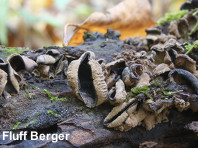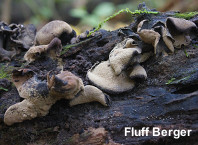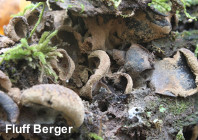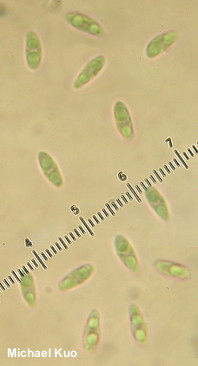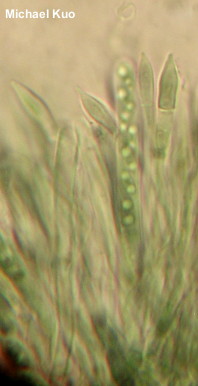| Major Groups > Cup Fungi > Ionomidotis irregularis |

|
Ionomidotis irregularis [ Ascomycota > Helotiales > Helotiaceae > Ionomidotis ... ] by Michael Kuo Distinctive but not often collected, this cup fungus grows on the deadwood of hardwoods across northern North America, south to roughly Oregon, Iowa, and Pennsylvania. However, it is apparently more common in northeastern North America than elsewhere, to judge from collection records in the continent's major herbaria. Ionomidotis irregularis can be recognized without a microscope by its clustered growth (several cups usually share a poorly-defined stem structure), its nearly black upper surface, its powdery buff under surface, and the way the cups stretch out to become elongated. Under the microscope, Ionomidotis irregularis features very distinctive, spear-tipped paraphyses. Midotis irregularis is a synonym. Thanks to Fluff Berger for collecting, documenting, and preserving Ionomidotis irregularis for study; her collection is deposited in The Herbarium of Michael Kuo. Description: Ecology: Presumably saprobic; appearing on the well-decayed, barkless wood of hardwoods; usually growing gregariously; fall and early winter; apparently widely distributed in North America from roughly the 40th Parallel northwards, but much more frequently collected in northeastern North America. The illustrated and described collection is from Pennsylvania. Fruiting Body: Usually consisting of several cups sharing a rudimentary, hard-to-see stem structure; individual cups 0.5–3 cm across, round in outline at first but often becoming elongated in one dimension, with the edges folded slightly inward; upper surface bald, very dark brown to nearly black; outer surface dark brown but usually covered with a buff-colored, powdery, pustulate scurf that is easily rubbed off; flesh slightly leathery, purplish black. Odor: Not distinctive. Chemical Reactions: KOH on flesh and surfaces purple to purplish brown (Zhuang, 1988); also ammonia (Běťák et al., 2012). Microscopic Features: Spores 6–8 x 2–2.5 µm; long-ellipsoid to suballantoid; smooth; hyaline and biguttulate in KOH. Asci REFERENCES: (Schweinitz, 1832) E. J. Durand, 1923. (Saccardo, 1889; Seaver, 1951; Zhuang, 1988; Běťák et al., 2012; Beug et al., 2014.) Herb. Kuo 10231605. This site contains no information about the edibility or toxicity of mushrooms. |
© MushroomExpert.Com |
|
Cite this page as: Kuo, M. (2017, May). Ionomidotis irregularis. Retrieved from the MushroomExpert.Com Web site: http://www.mushroomexpert.com/ionomidotis_irregularis.html |
